University of Dhaka: JetBlue Airways IPO Valuation Project
VerifiedAdded on 2021/09/08
|20
|4727
|65
Project
AI Summary
This project is a comprehensive analysis of the JetBlue Airways IPO valuation. It begins with an introduction to the company and the scope of the study, followed by an analysis of the economic conditions and industry dynamics, including Porter's Five Forces and PESTEL analysis. The report then delves into a company analysis, including SWOT analysis, ratio analysis (profitability, liquidity, and risk), DuPont analysis, and Z-score calculations to assess financial distress. The core problem statement focuses on determining the optimal IPO offer price. The report explores alternative courses of action, including overpricing and underpricing scenarios, and utilizes discounted cash flow (DCF) and multiple valuation methods to arrive at a recommendation. The project aims to provide a detailed valuation of the JetBlue Airways IPO and suggest an ideal price for the stocks.
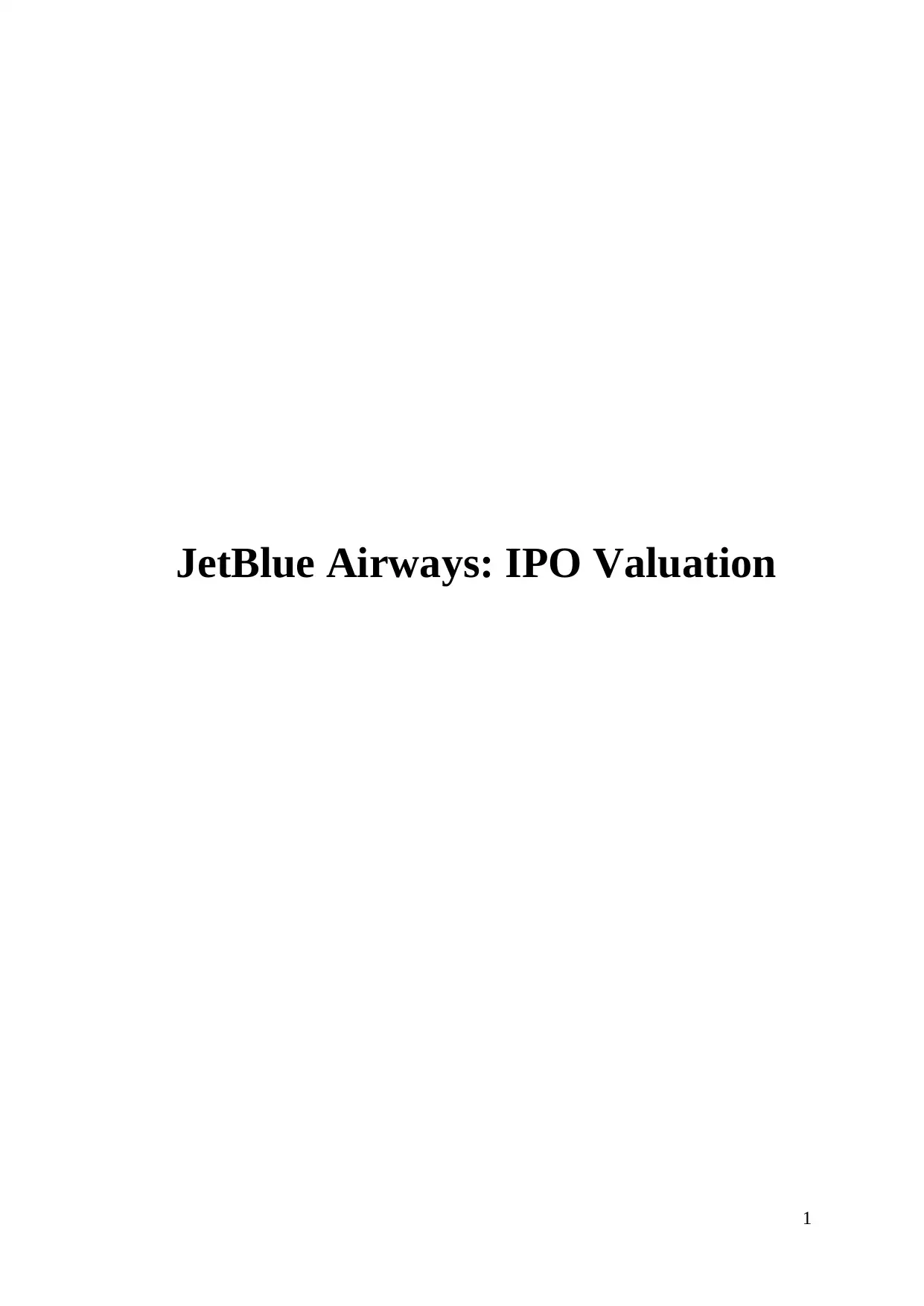
1
JetBlue Airways: IPO Valuation
JetBlue Airways: IPO Valuation
Paraphrase This Document
Need a fresh take? Get an instant paraphrase of this document with our AI Paraphraser
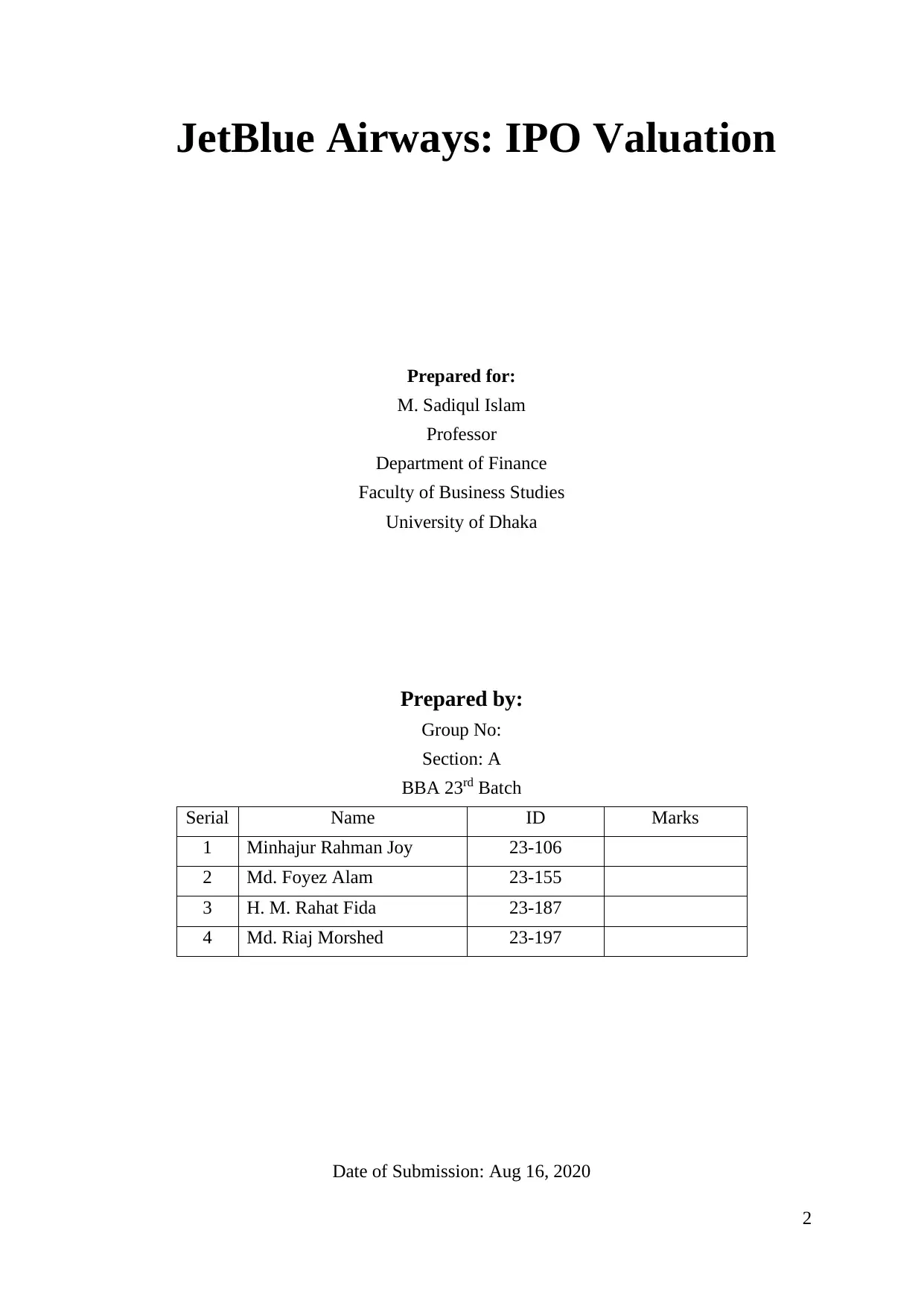
2
JetBlue Airways: IPO Valuation
Prepared for:
M. Sadiqul Islam
Professor
Department of Finance
Faculty of Business Studies
University of Dhaka
Prepared by:
Group No:
Section: A
BBA 23rd Batch
Serial Name ID Marks
1 Minhajur Rahman Joy 23-106
2 Md. Foyez Alam 23-155
3 H. M. Rahat Fida 23-187
4 Md. Riaj Morshed 23-197
Date of Submission: Aug 16, 2020
JetBlue Airways: IPO Valuation
Prepared for:
M. Sadiqul Islam
Professor
Department of Finance
Faculty of Business Studies
University of Dhaka
Prepared by:
Group No:
Section: A
BBA 23rd Batch
Serial Name ID Marks
1 Minhajur Rahman Joy 23-106
2 Md. Foyez Alam 23-155
3 H. M. Rahat Fida 23-187
4 Md. Riaj Morshed 23-197
Date of Submission: Aug 16, 2020
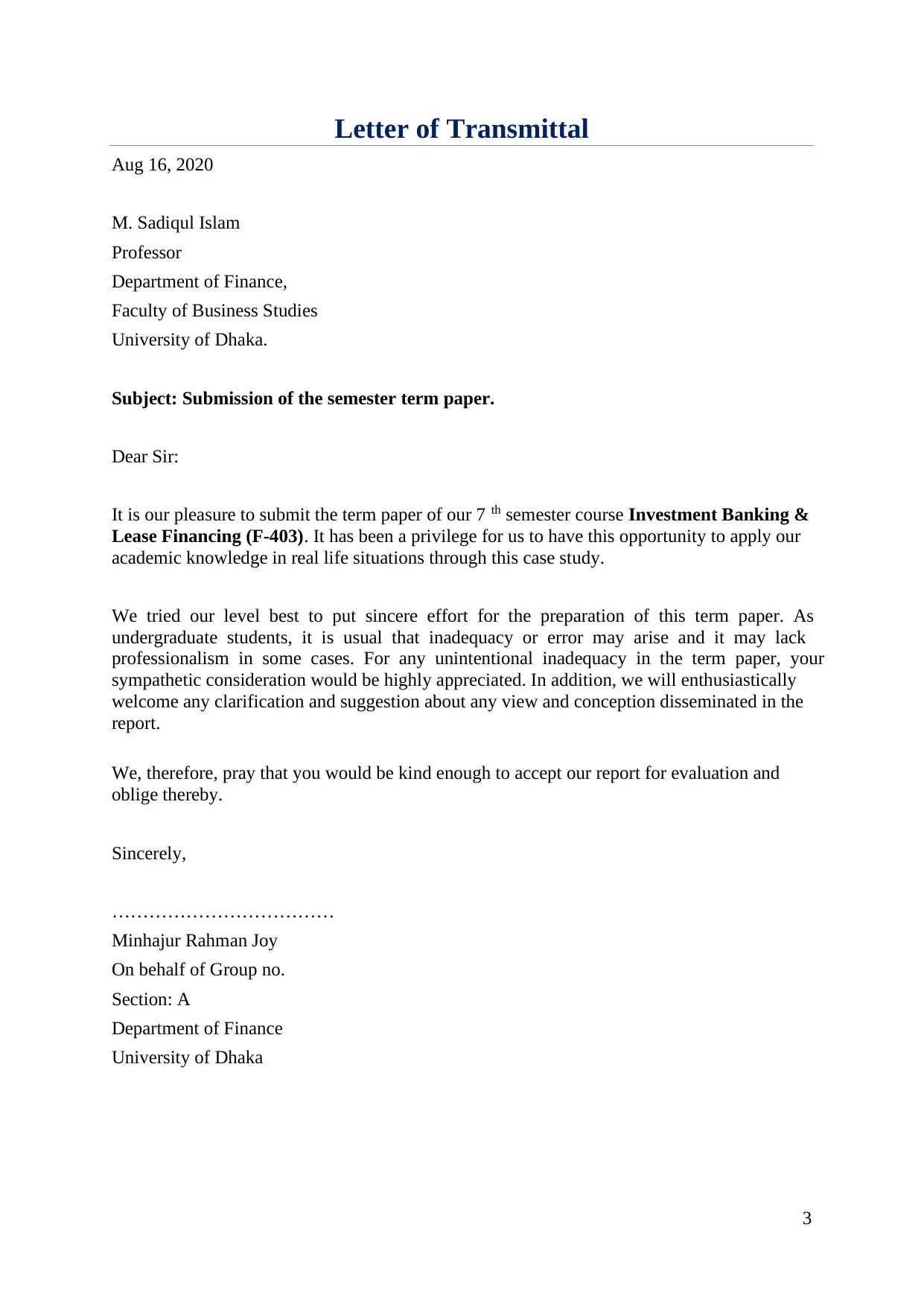
3
Letter of Transmittal
Aug 16, 2020
M. Sadiqul Islam
Professor
Department of Finance,
Faculty of Business Studies
University of Dhaka.
Subject: Submission of the semester term paper.
Dear Sir:
It is our pleasure to submit the term paper of our 7 th semester course Investment Banking &
Lease Financing (F-403). It has been a privilege for us to have this opportunity to apply our
academic knowledge in real life situations through this case study.
We tried our level best to put sincere effort for the preparation of this term paper. As
undergraduate students, it is usual that inadequacy or error may arise and it may lack
professionalism in some cases. For any unintentional inadequacy in the term paper, your
sympathetic consideration would be highly appreciated. In addition, we will enthusiastically
welcome any clarification and suggestion about any view and conception disseminated in the
report.
We, therefore, pray that you would be kind enough to accept our report for evaluation and
oblige thereby.
Sincerely,
………………………………
Minhajur Rahman Joy
On behalf of Group no.
Section: A
Department of Finance
University of Dhaka
Letter of Transmittal
Aug 16, 2020
M. Sadiqul Islam
Professor
Department of Finance,
Faculty of Business Studies
University of Dhaka.
Subject: Submission of the semester term paper.
Dear Sir:
It is our pleasure to submit the term paper of our 7 th semester course Investment Banking &
Lease Financing (F-403). It has been a privilege for us to have this opportunity to apply our
academic knowledge in real life situations through this case study.
We tried our level best to put sincere effort for the preparation of this term paper. As
undergraduate students, it is usual that inadequacy or error may arise and it may lack
professionalism in some cases. For any unintentional inadequacy in the term paper, your
sympathetic consideration would be highly appreciated. In addition, we will enthusiastically
welcome any clarification and suggestion about any view and conception disseminated in the
report.
We, therefore, pray that you would be kind enough to accept our report for evaluation and
oblige thereby.
Sincerely,
………………………………
Minhajur Rahman Joy
On behalf of Group no.
Section: A
Department of Finance
University of Dhaka
⊘ This is a preview!⊘
Do you want full access?
Subscribe today to unlock all pages.

Trusted by 1+ million students worldwide
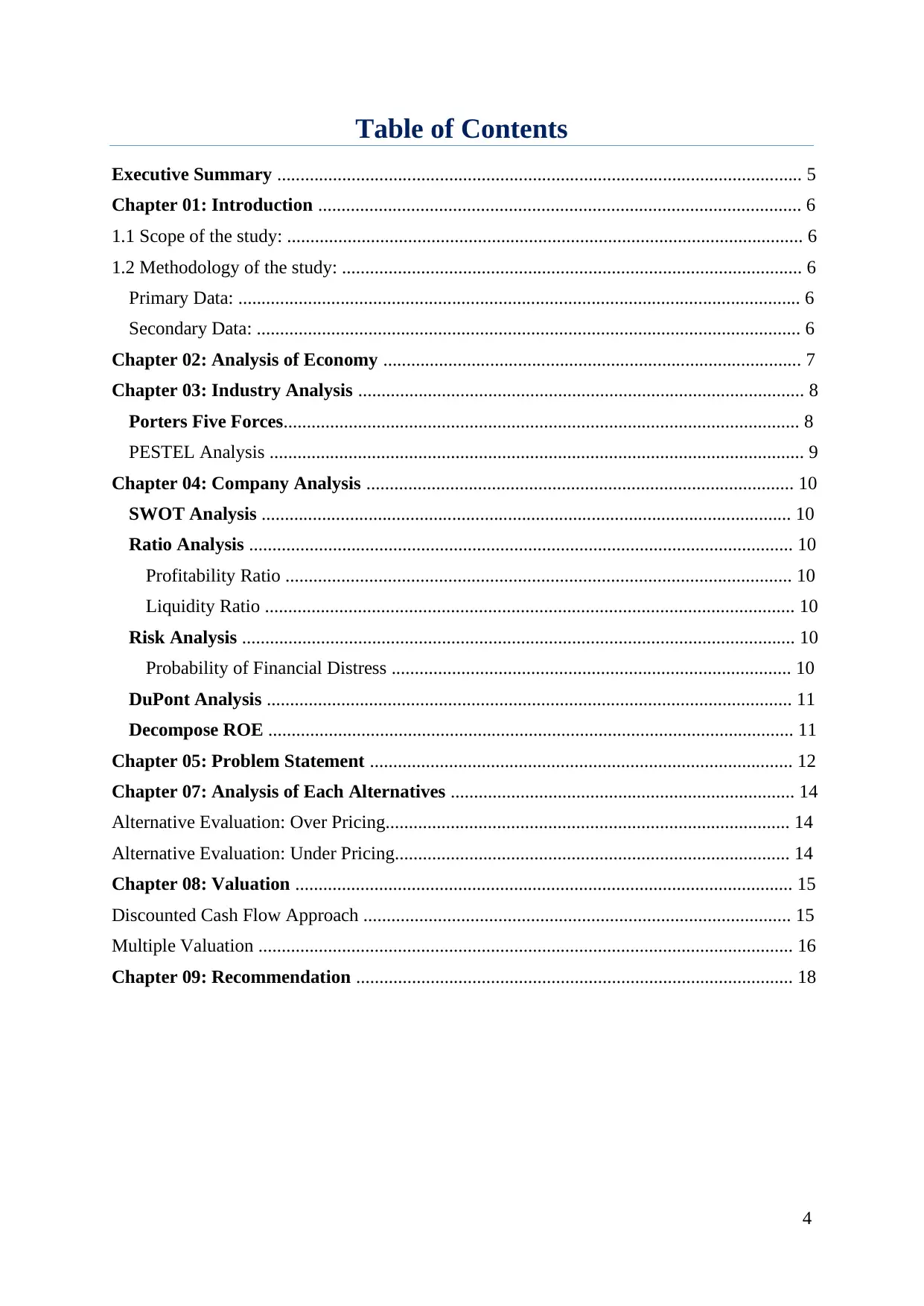
4
Table of Contents
Executive Summary ................................................................................................................. 5
Chapter 01: Introduction ........................................................................................................ 6
1.1 Scope of the study: ............................................................................................................... 6
1.2 Methodology of the study: ................................................................................................... 6
Primary Data: ......................................................................................................................... 6
Secondary Data: ..................................................................................................................... 6
Chapter 02: Analysis of Economy .......................................................................................... 7
Chapter 03: Industry Analysis ................................................................................................ 8
Porters Five Forces............................................................................................................... 8
PESTEL Analysis ................................................................................................................... 9
Chapter 04: Company Analysis ............................................................................................ 10
SWOT Analysis .................................................................................................................. 10
Ratio Analysis ..................................................................................................................... 10
Profitability Ratio ............................................................................................................. 10
Liquidity Ratio .................................................................................................................. 10
Risk Analysis ....................................................................................................................... 10
Probability of Financial Distress ...................................................................................... 10
DuPont Analysis ................................................................................................................. 11
Decompose ROE ................................................................................................................. 11
Chapter 05: Problem Statement ........................................................................................... 12
Chapter 07: Analysis of Each Alternatives .......................................................................... 14
Alternative Evaluation: Over Pricing....................................................................................... 14
Alternative Evaluation: Under Pricing..................................................................................... 14
Chapter 08: Valuation ........................................................................................................... 15
Discounted Cash Flow Approach ............................................................................................ 15
Multiple Valuation ................................................................................................................... 16
Chapter 09: Recommendation .............................................................................................. 18
Table of Contents
Executive Summary ................................................................................................................. 5
Chapter 01: Introduction ........................................................................................................ 6
1.1 Scope of the study: ............................................................................................................... 6
1.2 Methodology of the study: ................................................................................................... 6
Primary Data: ......................................................................................................................... 6
Secondary Data: ..................................................................................................................... 6
Chapter 02: Analysis of Economy .......................................................................................... 7
Chapter 03: Industry Analysis ................................................................................................ 8
Porters Five Forces............................................................................................................... 8
PESTEL Analysis ................................................................................................................... 9
Chapter 04: Company Analysis ............................................................................................ 10
SWOT Analysis .................................................................................................................. 10
Ratio Analysis ..................................................................................................................... 10
Profitability Ratio ............................................................................................................. 10
Liquidity Ratio .................................................................................................................. 10
Risk Analysis ....................................................................................................................... 10
Probability of Financial Distress ...................................................................................... 10
DuPont Analysis ................................................................................................................. 11
Decompose ROE ................................................................................................................. 11
Chapter 05: Problem Statement ........................................................................................... 12
Chapter 07: Analysis of Each Alternatives .......................................................................... 14
Alternative Evaluation: Over Pricing....................................................................................... 14
Alternative Evaluation: Under Pricing..................................................................................... 14
Chapter 08: Valuation ........................................................................................................... 15
Discounted Cash Flow Approach ............................................................................................ 15
Multiple Valuation ................................................................................................................... 16
Chapter 09: Recommendation .............................................................................................. 18
Paraphrase This Document
Need a fresh take? Get an instant paraphrase of this document with our AI Paraphraser
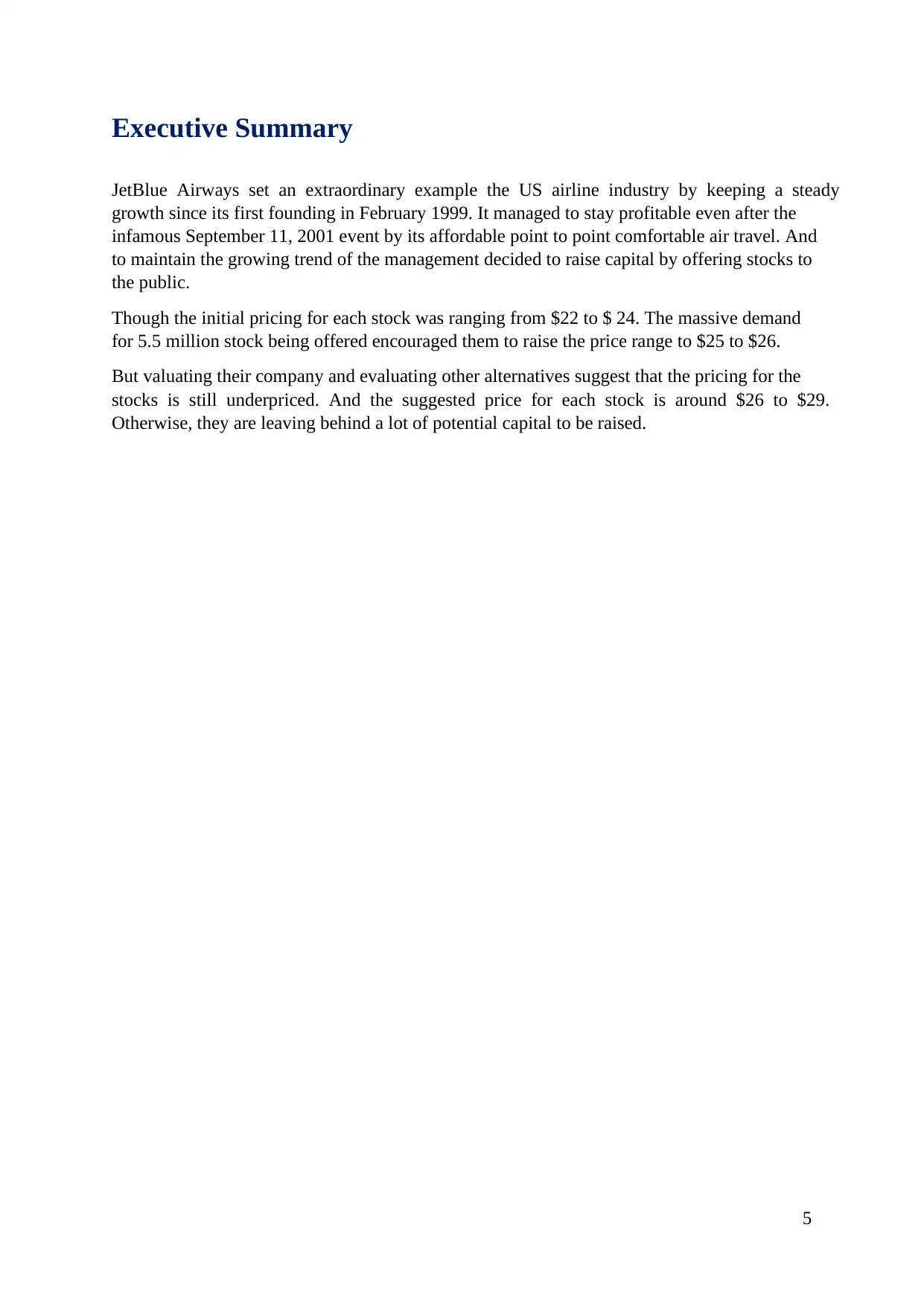
5
Executive Summary
JetBlue Airways set an extraordinary example the US airline industry by keeping a steady
growth since its first founding in February 1999. It managed to stay profitable even after the
infamous September 11, 2001 event by its affordable point to point comfortable air travel. And
to maintain the growing trend of the management decided to raise capital by offering stocks to
the public.
Though the initial pricing for each stock was ranging from $22 to $ 24. The massive demand
for 5.5 million stock being offered encouraged them to raise the price range to $25 to $26.
But valuating their company and evaluating other alternatives suggest that the pricing for the
stocks is still underpriced. And the suggested price for each stock is around $26 to $29.
Otherwise, they are leaving behind a lot of potential capital to be raised.
Executive Summary
JetBlue Airways set an extraordinary example the US airline industry by keeping a steady
growth since its first founding in February 1999. It managed to stay profitable even after the
infamous September 11, 2001 event by its affordable point to point comfortable air travel. And
to maintain the growing trend of the management decided to raise capital by offering stocks to
the public.
Though the initial pricing for each stock was ranging from $22 to $ 24. The massive demand
for 5.5 million stock being offered encouraged them to raise the price range to $25 to $26.
But valuating their company and evaluating other alternatives suggest that the pricing for the
stocks is still underpriced. And the suggested price for each stock is around $26 to $29.
Otherwise, they are leaving behind a lot of potential capital to be raised.
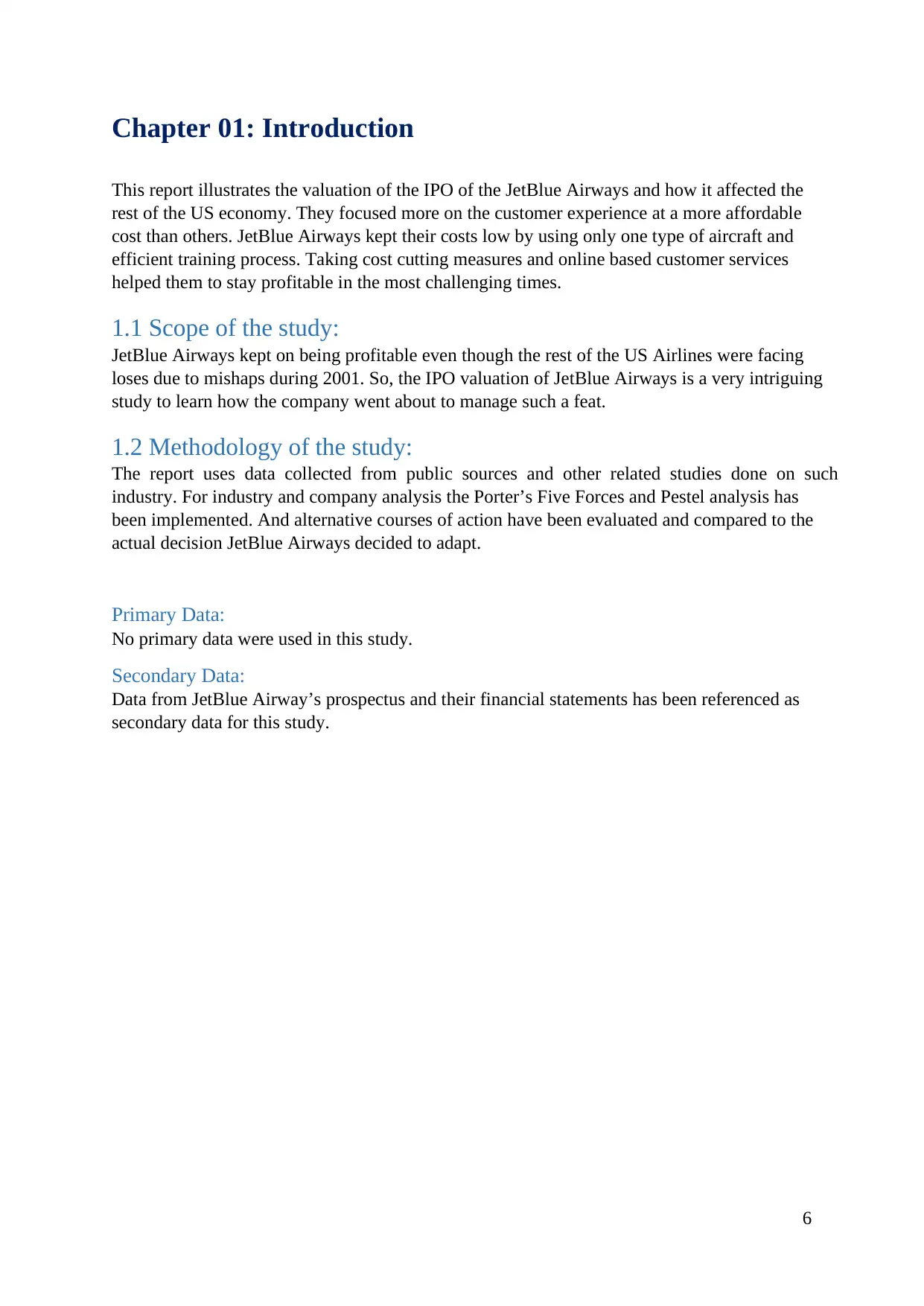
6
Chapter 01: Introduction
This report illustrates the valuation of the IPO of the JetBlue Airways and how it affected the
rest of the US economy. They focused more on the customer experience at a more affordable
cost than others. JetBlue Airways kept their costs low by using only one type of aircraft and
efficient training process. Taking cost cutting measures and online based customer services
helped them to stay profitable in the most challenging times.
1.1 Scope of the study:
JetBlue Airways kept on being profitable even though the rest of the US Airlines were facing
loses due to mishaps during 2001. So, the IPO valuation of JetBlue Airways is a very intriguing
study to learn how the company went about to manage such a feat.
1.2 Methodology of the study:
The report uses data collected from public sources and other related studies done on such
industry. For industry and company analysis the Porter’s Five Forces and Pestel analysis has
been implemented. And alternative courses of action have been evaluated and compared to the
actual decision JetBlue Airways decided to adapt.
Primary Data:
No primary data were used in this study.
Secondary Data:
Data from JetBlue Airway’s prospectus and their financial statements has been referenced as
secondary data for this study.
Chapter 01: Introduction
This report illustrates the valuation of the IPO of the JetBlue Airways and how it affected the
rest of the US economy. They focused more on the customer experience at a more affordable
cost than others. JetBlue Airways kept their costs low by using only one type of aircraft and
efficient training process. Taking cost cutting measures and online based customer services
helped them to stay profitable in the most challenging times.
1.1 Scope of the study:
JetBlue Airways kept on being profitable even though the rest of the US Airlines were facing
loses due to mishaps during 2001. So, the IPO valuation of JetBlue Airways is a very intriguing
study to learn how the company went about to manage such a feat.
1.2 Methodology of the study:
The report uses data collected from public sources and other related studies done on such
industry. For industry and company analysis the Porter’s Five Forces and Pestel analysis has
been implemented. And alternative courses of action have been evaluated and compared to the
actual decision JetBlue Airways decided to adapt.
Primary Data:
No primary data were used in this study.
Secondary Data:
Data from JetBlue Airway’s prospectus and their financial statements has been referenced as
secondary data for this study.
⊘ This is a preview!⊘
Do you want full access?
Subscribe today to unlock all pages.

Trusted by 1+ million students worldwide
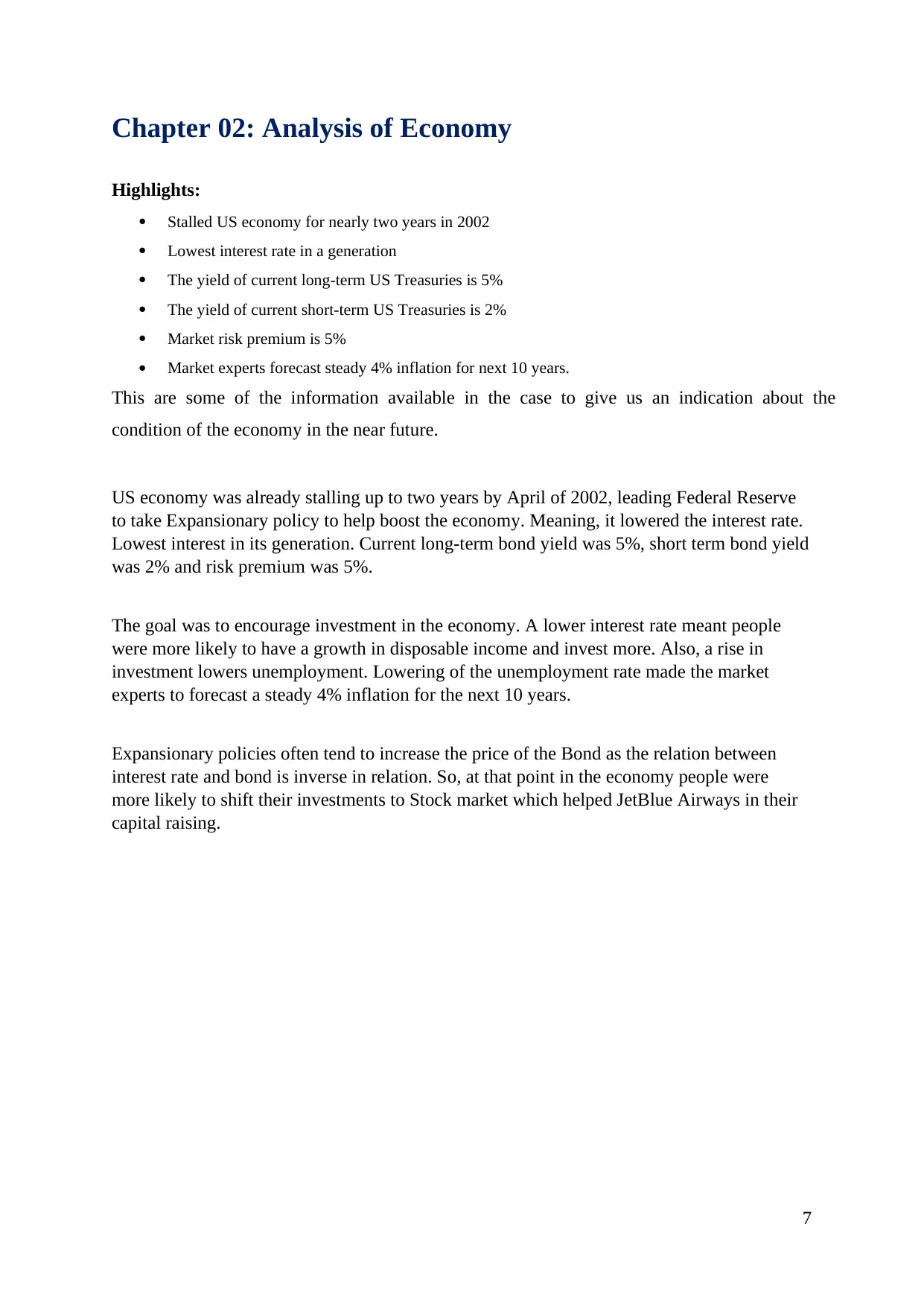
7
Chapter 02: Analysis of Economy
Highlights:
Stalled US economy for nearly two years in 2002
Lowest interest rate in a generation
The yield of current long-term US Treasuries is 5%
The yield of current short-term US Treasuries is 2%
Market risk premium is 5%
Market experts forecast steady 4% inflation for next 10 years.
This are some of the information available in the case to give us an indication about the
condition of the economy in the near future.
US economy was already stalling up to two years by April of 2002, leading Federal Reserve
to take Expansionary policy to help boost the economy. Meaning, it lowered the interest rate.
Lowest interest in its generation. Current long-term bond yield was 5%, short term bond yield
was 2% and risk premium was 5%.
The goal was to encourage investment in the economy. A lower interest rate meant people
were more likely to have a growth in disposable income and invest more. Also, a rise in
investment lowers unemployment. Lowering of the unemployment rate made the market
experts to forecast a steady 4% inflation for the next 10 years.
Expansionary policies often tend to increase the price of the Bond as the relation between
interest rate and bond is inverse in relation. So, at that point in the economy people were
more likely to shift their investments to Stock market which helped JetBlue Airways in their
capital raising.
Chapter 02: Analysis of Economy
Highlights:
Stalled US economy for nearly two years in 2002
Lowest interest rate in a generation
The yield of current long-term US Treasuries is 5%
The yield of current short-term US Treasuries is 2%
Market risk premium is 5%
Market experts forecast steady 4% inflation for next 10 years.
This are some of the information available in the case to give us an indication about the
condition of the economy in the near future.
US economy was already stalling up to two years by April of 2002, leading Federal Reserve
to take Expansionary policy to help boost the economy. Meaning, it lowered the interest rate.
Lowest interest in its generation. Current long-term bond yield was 5%, short term bond yield
was 2% and risk premium was 5%.
The goal was to encourage investment in the economy. A lower interest rate meant people
were more likely to have a growth in disposable income and invest more. Also, a rise in
investment lowers unemployment. Lowering of the unemployment rate made the market
experts to forecast a steady 4% inflation for the next 10 years.
Expansionary policies often tend to increase the price of the Bond as the relation between
interest rate and bond is inverse in relation. So, at that point in the economy people were
more likely to shift their investments to Stock market which helped JetBlue Airways in their
capital raising.
Paraphrase This Document
Need a fresh take? Get an instant paraphrase of this document with our AI Paraphraser
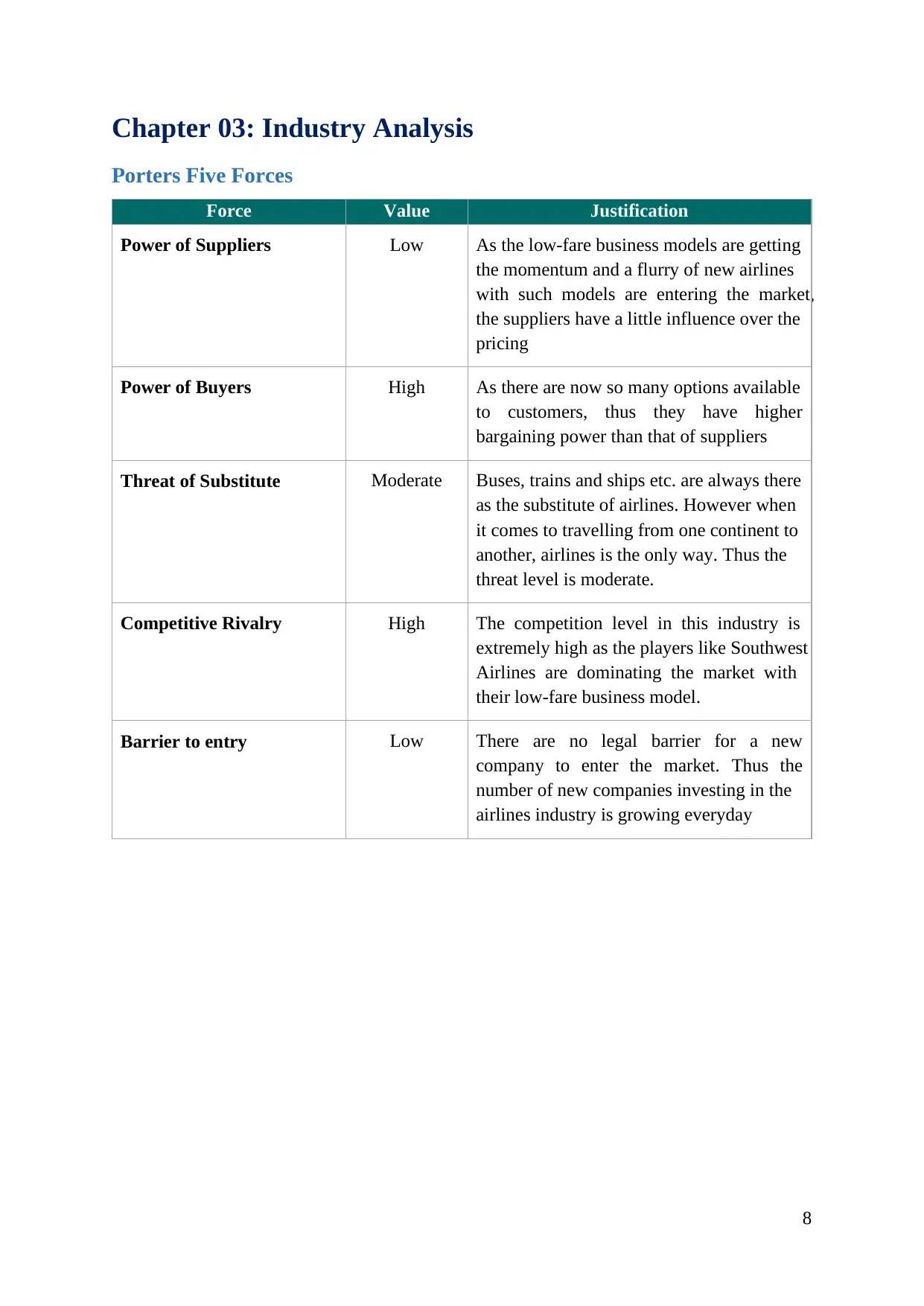
8
Chapter 03: Industry Analysis
Porters Five Forces
Force Value Justification
Power of Suppliers Low As the low-fare business models are getting
the momentum and a flurry of new airlines
with such models are entering the market,
the suppliers have a little influence over the
pricing
Power of Buyers High As there are now so many options available
to customers, thus they have higher
bargaining power than that of suppliers
Threat of Substitute Moderate Buses, trains and ships etc. are always there
as the substitute of airlines. However when
it comes to travelling from one continent to
another, airlines is the only way. Thus the
threat level is moderate.
Competitive Rivalry High The competition level in this industry is
extremely high as the players like Southwest
Airlines are dominating the market with
their low-fare business model.
Barrier to entry Low There are no legal barrier for a new
company to enter the market. Thus the
number of new companies investing in the
airlines industry is growing everyday
Chapter 03: Industry Analysis
Porters Five Forces
Force Value Justification
Power of Suppliers Low As the low-fare business models are getting
the momentum and a flurry of new airlines
with such models are entering the market,
the suppliers have a little influence over the
pricing
Power of Buyers High As there are now so many options available
to customers, thus they have higher
bargaining power than that of suppliers
Threat of Substitute Moderate Buses, trains and ships etc. are always there
as the substitute of airlines. However when
it comes to travelling from one continent to
another, airlines is the only way. Thus the
threat level is moderate.
Competitive Rivalry High The competition level in this industry is
extremely high as the players like Southwest
Airlines are dominating the market with
their low-fare business model.
Barrier to entry Low There are no legal barrier for a new
company to enter the market. Thus the
number of new companies investing in the
airlines industry is growing everyday
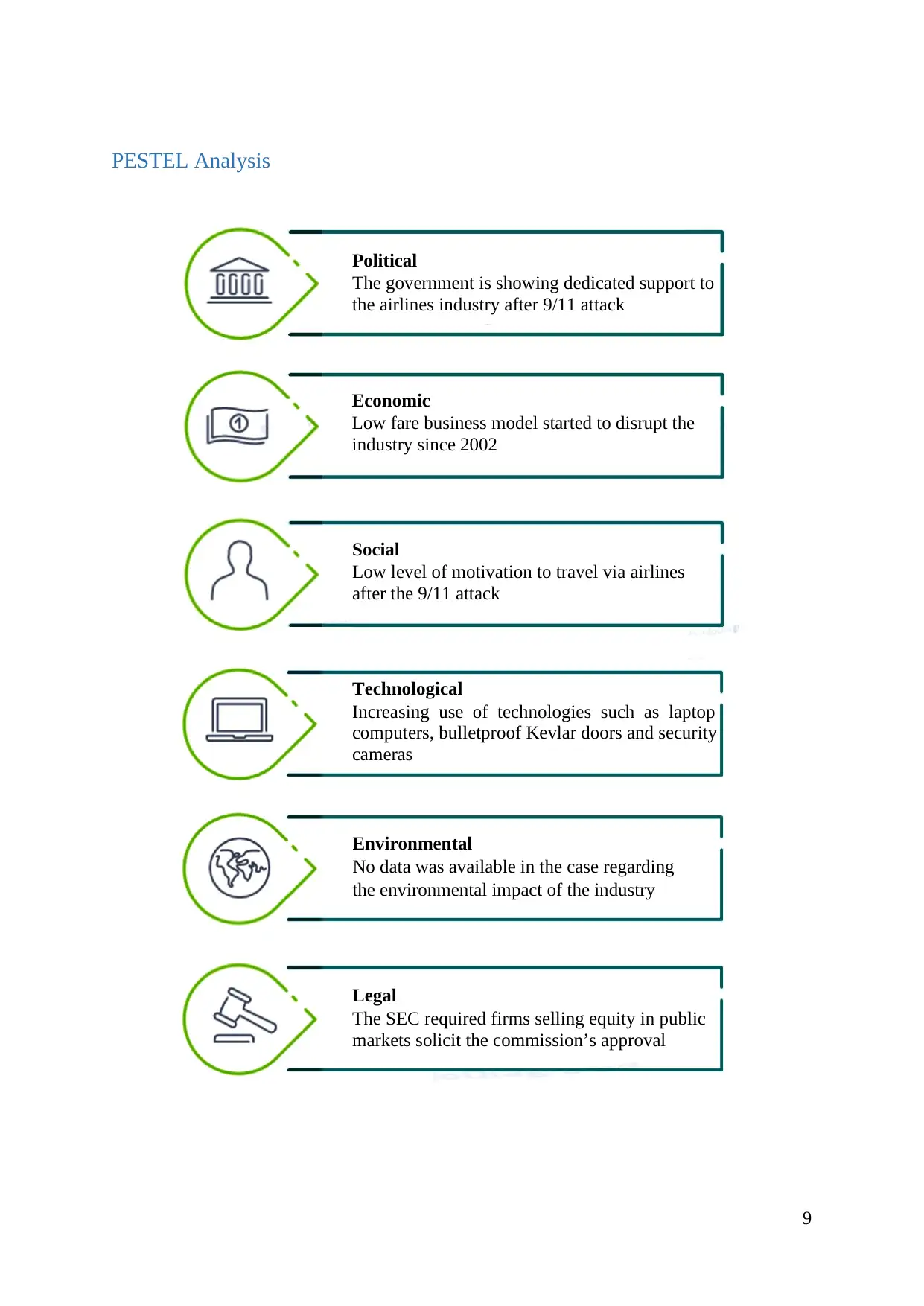
9
PESTEL Analysis
Economic
Low fare business model started to disrupt the
industry since 2002
Social
Low level of motivation to travel via airlines
after the 9/11 attack
Environmental
No data was available in the case regarding
the environmental impact of the industry
Political
The government is showing dedicated support to
the airlines industry after 9/11 attack
Technological
Increasing use of technologies such as laptop
computers, bulletproof Kevlar doors and security
cameras
Legal
The SEC required firms selling equity in public
markets solicit the commission’s approval
PESTEL Analysis
Economic
Low fare business model started to disrupt the
industry since 2002
Social
Low level of motivation to travel via airlines
after the 9/11 attack
Environmental
No data was available in the case regarding
the environmental impact of the industry
Political
The government is showing dedicated support to
the airlines industry after 9/11 attack
Technological
Increasing use of technologies such as laptop
computers, bulletproof Kevlar doors and security
cameras
Legal
The SEC required firms selling equity in public
markets solicit the commission’s approval
⊘ This is a preview!⊘
Do you want full access?
Subscribe today to unlock all pages.

Trusted by 1+ million students worldwide
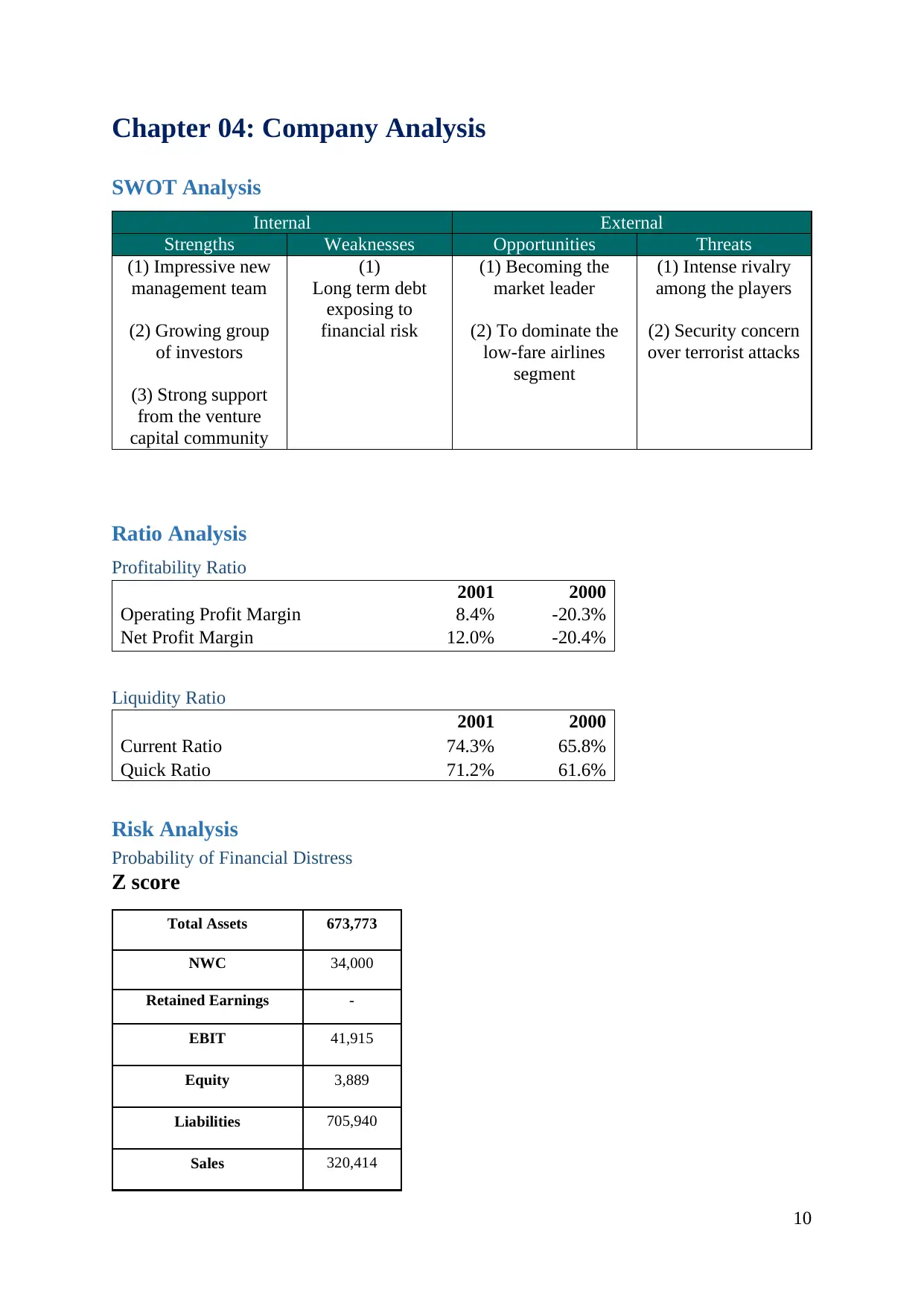
10
Chapter 04: Company Analysis
SWOT Analysis
Internal External
Strengths Weaknesses Opportunities Threats
(1) Impressive new
management team
(2) Growing group
of investors
(3) Strong support
from the venture
capital community
(1)
Long term debt
exposing to
financial risk
(1) Becoming the
market leader
(2) To dominate the
low-fare airlines
segment
(1) Intense rivalry
among the players
(2) Security concern
over terrorist attacks
Ratio Analysis
Profitability Ratio
2001 2000
Operating Profit Margin 8.4% -20.3%
Net Profit Margin 12.0% -20.4%
Liquidity Ratio
2001 2000
Current Ratio 74.3% 65.8%
Quick Ratio 71.2% 61.6%
Risk Analysis
Probability of Financial Distress
Z score
Total Assets 673,773
NWC 34,000
Retained Earnings -
EBIT 41,915
Equity 3,889
Liabilities 705,940
Sales 320,414
Chapter 04: Company Analysis
SWOT Analysis
Internal External
Strengths Weaknesses Opportunities Threats
(1) Impressive new
management team
(2) Growing group
of investors
(3) Strong support
from the venture
capital community
(1)
Long term debt
exposing to
financial risk
(1) Becoming the
market leader
(2) To dominate the
low-fare airlines
segment
(1) Intense rivalry
among the players
(2) Security concern
over terrorist attacks
Ratio Analysis
Profitability Ratio
2001 2000
Operating Profit Margin 8.4% -20.3%
Net Profit Margin 12.0% -20.4%
Liquidity Ratio
2001 2000
Current Ratio 74.3% 65.8%
Quick Ratio 71.2% 61.6%
Risk Analysis
Probability of Financial Distress
Z score
Total Assets 673,773
NWC 34,000
Retained Earnings -
EBIT 41,915
Equity 3,889
Liabilities 705,940
Sales 320,414
Paraphrase This Document
Need a fresh take? Get an instant paraphrase of this document with our AI Paraphraser
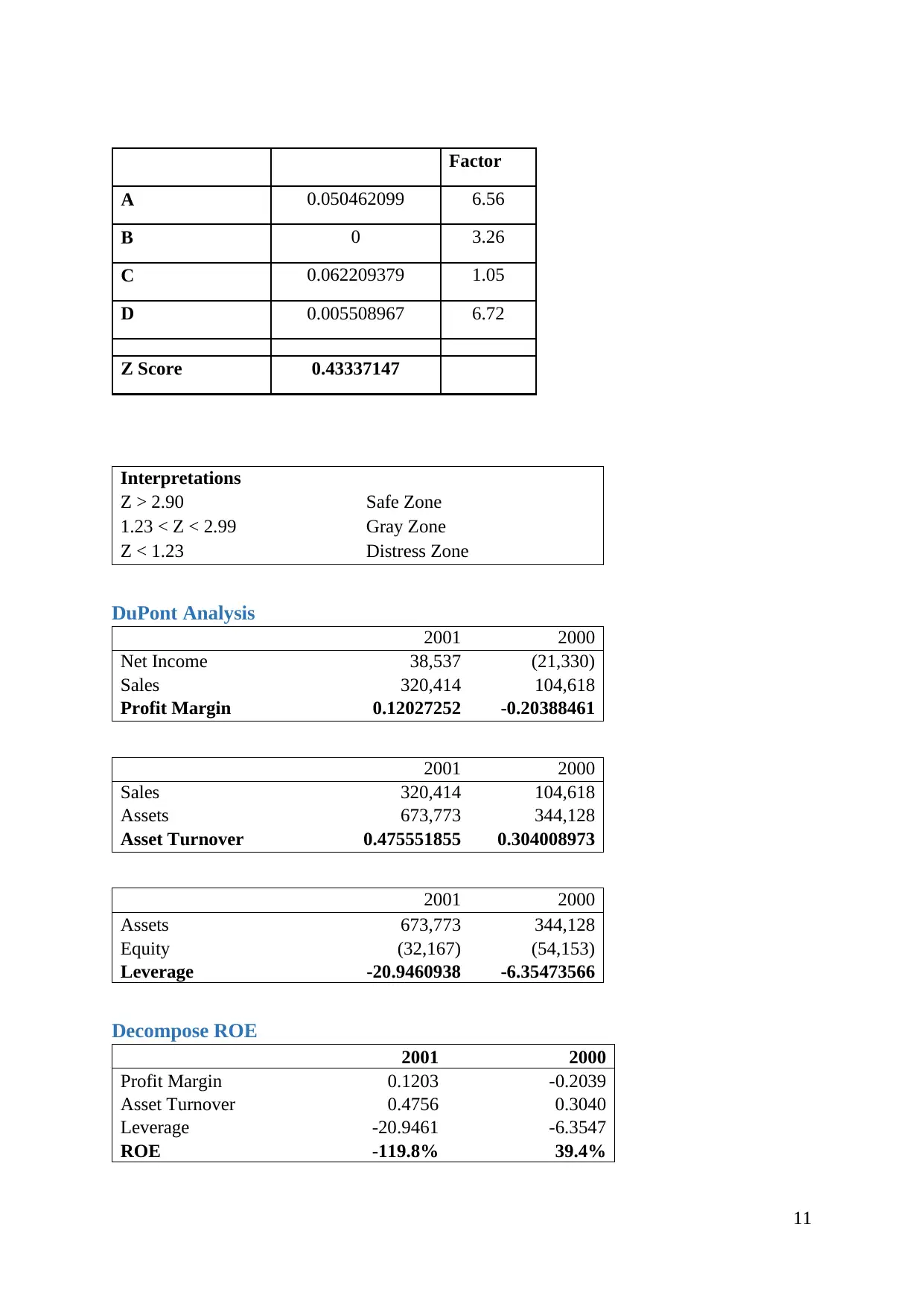
11
Factor
A 0.050462099 6.56
B 0 3.26
C 0.062209379 1.05
D 0.005508967 6.72
Z Score 0.43337147
Interpretations
Z > 2.90 Safe Zone
1.23 < Z < 2.99 Gray Zone
Z < 1.23 Distress Zone
DuPont Analysis
2001 2000
Net Income 38,537 (21,330)
Sales 320,414 104,618
Profit Margin 0.12027252 -0.20388461
2001 2000
Sales 320,414 104,618
Assets 673,773 344,128
Asset Turnover 0.475551855 0.304008973
2001 2000
Assets 673,773 344,128
Equity (32,167) (54,153)
Leverage -20.9460938 -6.35473566
Decompose ROE
2001 2000
Profit Margin 0.1203 -0.2039
Asset Turnover 0.4756 0.3040
Leverage -20.9461 -6.3547
ROE -119.8% 39.4%
Factor
A 0.050462099 6.56
B 0 3.26
C 0.062209379 1.05
D 0.005508967 6.72
Z Score 0.43337147
Interpretations
Z > 2.90 Safe Zone
1.23 < Z < 2.99 Gray Zone
Z < 1.23 Distress Zone
DuPont Analysis
2001 2000
Net Income 38,537 (21,330)
Sales 320,414 104,618
Profit Margin 0.12027252 -0.20388461
2001 2000
Sales 320,414 104,618
Assets 673,773 344,128
Asset Turnover 0.475551855 0.304008973
2001 2000
Assets 673,773 344,128
Equity (32,167) (54,153)
Leverage -20.9460938 -6.35473566
Decompose ROE
2001 2000
Profit Margin 0.1203 -0.2039
Asset Turnover 0.4756 0.3040
Leverage -20.9461 -6.3547
ROE -119.8% 39.4%
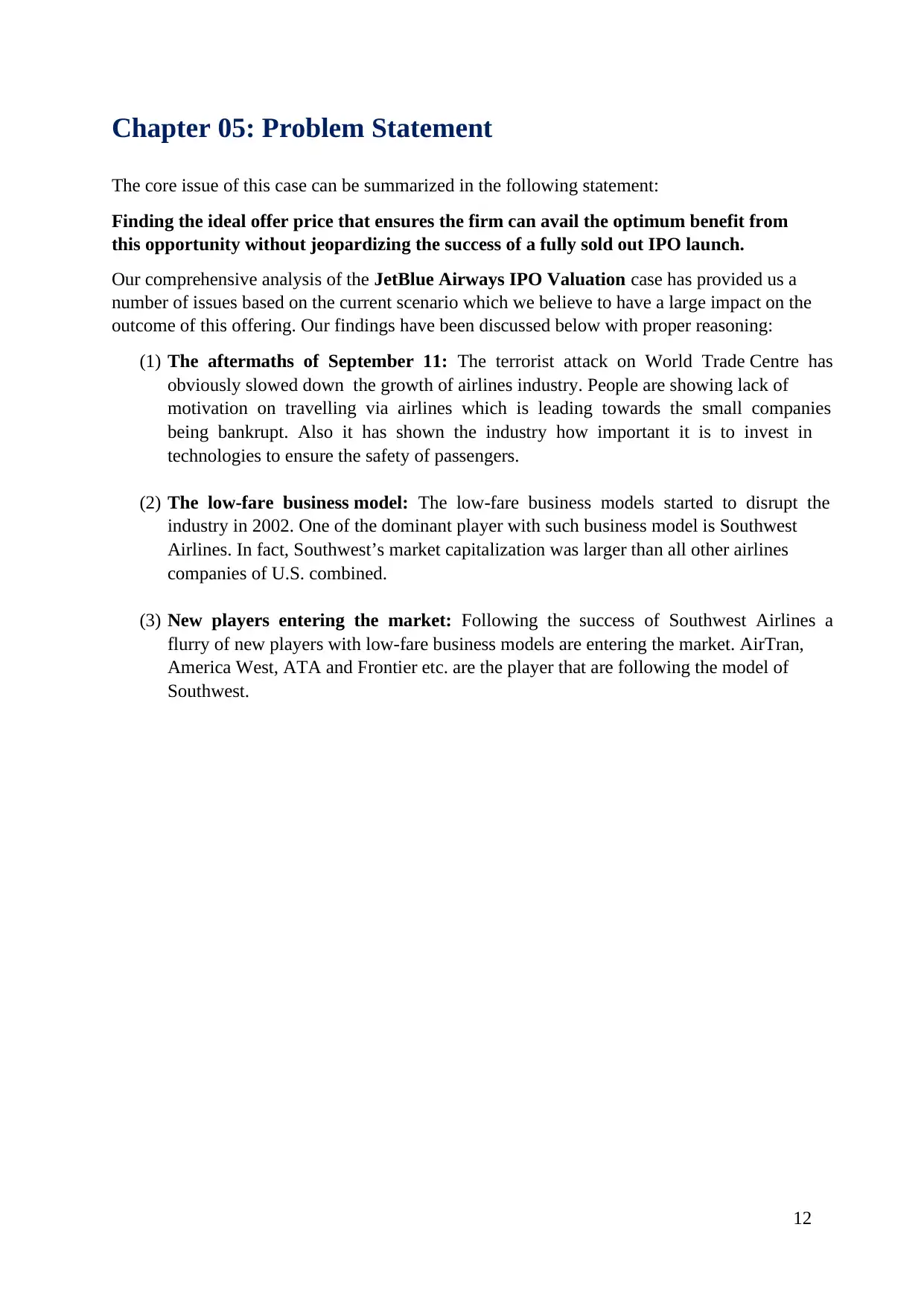
12
Chapter 05: Problem Statement
The core issue of this case can be summarized in the following statement:
Finding the ideal offer price that ensures the firm can avail the optimum benefit from
this opportunity without jeopardizing the success of a fully sold out IPO launch.
Our comprehensive analysis of the JetBlue Airways IPO Valuation case has provided us a
number of issues based on the current scenario which we believe to have a large impact on the
outcome of this offering. Our findings have been discussed below with proper reasoning:
(1) The aftermaths of September 11: The terrorist attack on World Trade Centre has
obviously slowed down the growth of airlines industry. People are showing lack of
motivation on travelling via airlines which is leading towards the small companies
being bankrupt. Also it has shown the industry how important it is to invest in
technologies to ensure the safety of passengers.
(2) The low-fare business model: The low-fare business models started to disrupt the
industry in 2002. One of the dominant player with such business model is Southwest
Airlines. In fact, Southwest’s market capitalization was larger than all other airlines
companies of U.S. combined.
(3) New players entering the market: Following the success of Southwest Airlines a
flurry of new players with low-fare business models are entering the market. AirTran,
America West, ATA and Frontier etc. are the player that are following the model of
Southwest.
Chapter 05: Problem Statement
The core issue of this case can be summarized in the following statement:
Finding the ideal offer price that ensures the firm can avail the optimum benefit from
this opportunity without jeopardizing the success of a fully sold out IPO launch.
Our comprehensive analysis of the JetBlue Airways IPO Valuation case has provided us a
number of issues based on the current scenario which we believe to have a large impact on the
outcome of this offering. Our findings have been discussed below with proper reasoning:
(1) The aftermaths of September 11: The terrorist attack on World Trade Centre has
obviously slowed down the growth of airlines industry. People are showing lack of
motivation on travelling via airlines which is leading towards the small companies
being bankrupt. Also it has shown the industry how important it is to invest in
technologies to ensure the safety of passengers.
(2) The low-fare business model: The low-fare business models started to disrupt the
industry in 2002. One of the dominant player with such business model is Southwest
Airlines. In fact, Southwest’s market capitalization was larger than all other airlines
companies of U.S. combined.
(3) New players entering the market: Following the success of Southwest Airlines a
flurry of new players with low-fare business models are entering the market. AirTran,
America West, ATA and Frontier etc. are the player that are following the model of
Southwest.
⊘ This is a preview!⊘
Do you want full access?
Subscribe today to unlock all pages.

Trusted by 1+ million students worldwide
1 out of 20
Your All-in-One AI-Powered Toolkit for Academic Success.
+13062052269
info@desklib.com
Available 24*7 on WhatsApp / Email
![[object Object]](/_next/static/media/star-bottom.7253800d.svg)
Unlock your academic potential
Copyright © 2020–2025 A2Z Services. All Rights Reserved. Developed and managed by ZUCOL.